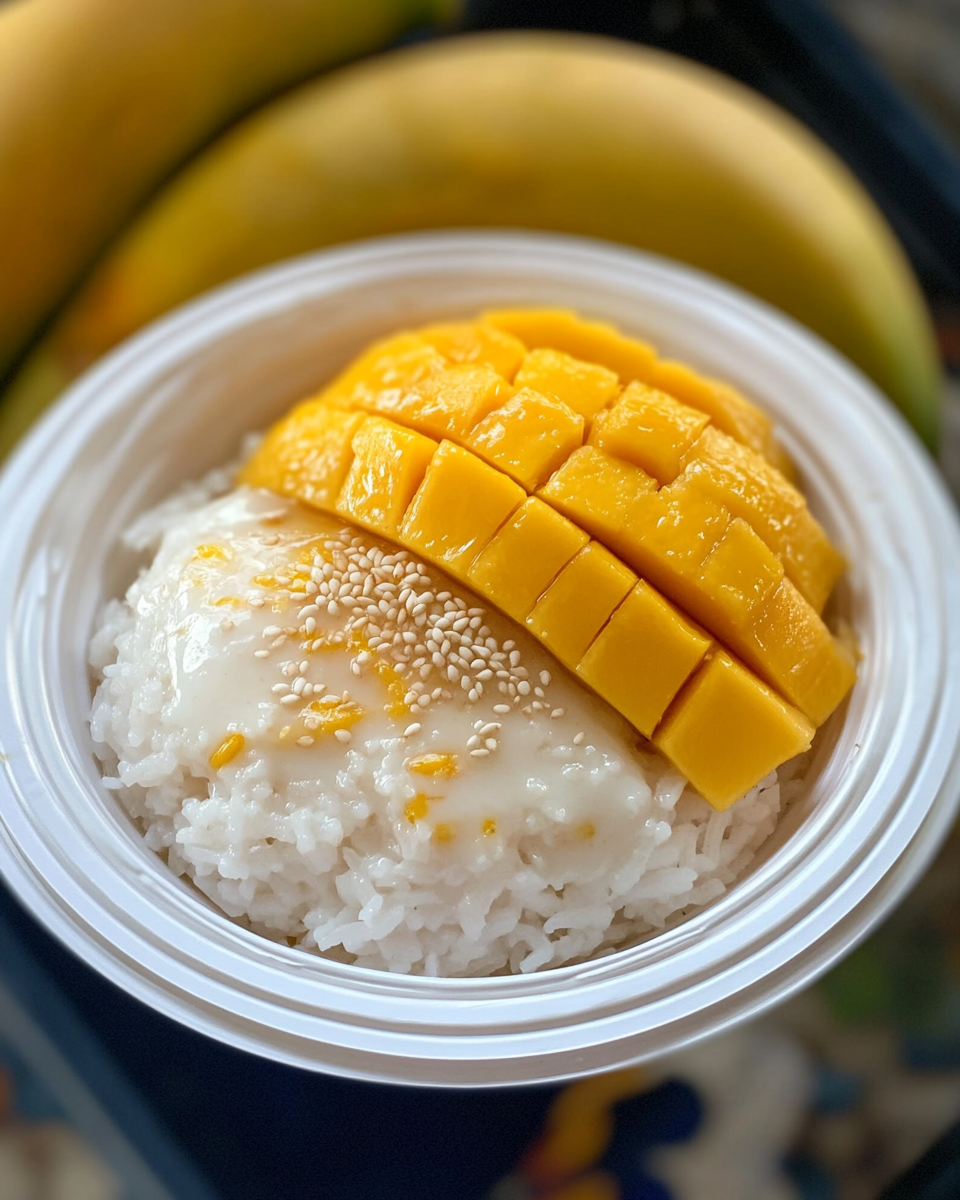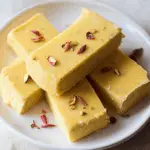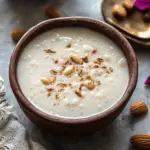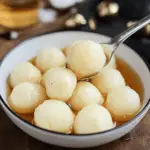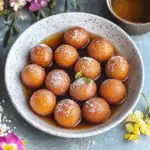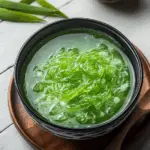This delicious dessert combines sweet coconut sticky rice with fresh, juicy mango slices for a tropical treat that’s perfect for any occasion.
FULL RECIPE
Ingredients
- 1 cup sticky rice (also called glutinous rice)
- 1 ½ cups coconut milk
- ¼ cup sugar
- ¼ teaspoon salt
- 2 ripe mangoes, peeled and sliced
- Sesame seeds (optional, for garnish)
Directions
- Rinse the sticky rice under cold water until the water runs clear.
- Soak the sticky rice in water for at least 30 minutes, or overnight if possible.
- Drain the rice and steam it for 20-25 minutes, until fully cooked and tender.
- While the rice is cooking, combine the coconut milk, sugar, and salt in a saucepan over medium heat.
- Stir the mixture until the sugar and salt are fully dissolved, then remove from heat.
- Once the rice is done, transfer it to a bowl and pour the coconut milk mixture over it.
- Stir gently to ensure the rice is evenly coated with the coconut milk, then let it sit for 15-20 minutes to absorb the flavors.
- To serve, scoop the sticky rice onto plates and arrange the mango slices on top.
- Garnish with sesame seeds if desired and serve warm or at room temperature.
Nutritional Information
- Calories: 250-300 per serving
- Carbohydrates: 45-50g
- Protein: 2-3g
- Fat: 7-10g
- Fiber: 1-2g
- Sugars: 20-25g
History of Mango Sticky Rice
Mango Sticky Rice, or “Khao Niew Mamuang” in Thai, is a traditional Thai dessert that has become beloved globally. Its origins are deeply rooted in Thai culture, where it was once a treat for royalty. Over time, it gained popularity among the general public and eventually became a street food staple in Thailand. The dessert combines two simple ingredients—sticky rice and ripe mangoes—and has become a symbol of the country’s tropical flavors. Often served during mango season, which typically peaks between April and June, this dish continues to delight people worldwide with its perfect balance of textures and flavors.
Cultural Significance
Mango Sticky Rice is not just a dessert; it’s a dish that holds cultural importance in Thailand. The mango is seen as a symbol of prosperity, while the sticky rice represents unity and strength, as it brings together the delicate coconut milk and the vibrant fruit. It’s commonly served during festivals, family gatherings, and celebrations, adding a sweet touch to any occasion. The dish has become a reflection of the Thai way of life—simple, yet full of meaning and warmth.
The Role of Sticky Rice in Thai Cuisine
Sticky rice, or glutinous rice, plays a vital role in Thai cuisine. Unlike regular rice, it has a unique, sticky texture that makes it a perfect accompaniment to both savory and sweet dishes. For Mango Sticky Rice, sticky rice acts as the foundation, soaking up the creamy coconut milk and balancing the sweetness of the mango. This rice is dense and chewy, creating a satisfying contrast with the soft, juicy fruit. In Thailand, sticky rice is often considered a staple food, commonly served with both main courses and desserts.
Mango Variety for the Dish
When preparing Mango Sticky Rice, selecting the right variety of mango is crucial for achieving the perfect flavor and texture. Thai mango varieties like Nam Dok Mai and Keo Savoy are prized for their sweetness, smoothness, and minimal fiber. These mangoes are easy to slice, making them ideal for the dish. It’s important to use ripe, yet firm mangoes. Overripe mangoes can become too mushy, while underripe ones may lack the sweetness and flavor needed to complement the sticky rice.
Coconut Milk’s Importance
Coconut milk is the key ingredient that gives Mango Sticky Rice its signature richness and creaminess. The coconut milk used should be full-fat to create a velvety texture that coats the sticky rice. The milk is infused with sugar and a pinch of salt to provide a perfect balance of sweetness and a hint of savory depth. This mixture adds a luxurious quality to the rice, allowing each bite to be soft and satisfying.
Sweetness Balance
The key to a great Mango Sticky Rice is balancing the sweetness. The coconut milk mixture provides a rich sweetness to the sticky rice, while the mango brings its natural sugars. Achieving the perfect harmony between these two is what makes this dessert truly special. Too much sugar in the coconut milk can overwhelm the delicate flavor of the mango, while too little can leave the rice tasting bland. It’s all about finding the right level of sweetness that allows both the rice and mango to shine.
The Texture of the Rice
The texture of the sticky rice is crucial to creating the perfect Mango Sticky Rice. The rice should be soft and tender, but not overly mushy. It should absorb the coconut milk, becoming sticky but still retaining a slight chew. The key to getting the texture just right lies in steaming the rice. Boiling it will make it too soft, but steaming it ensures that the grains stay intact and have the right texture to complement the other ingredients.
Serving Suggestions
Mango Sticky Rice is traditionally served as an individual dessert, with the sticky rice placed alongside the fresh mango slices. The contrasting textures—creamy rice and juicy, smooth mango—create a delightful combination. Some variations of the dish include garnishing it with sesame seeds, mung beans, or even a drizzle of extra coconut cream. This adds extra flavor and texture, while enhancing the presentation. The dish can be served warm, at room temperature, or even chilled, depending on personal preference.
Variations of Mango Sticky Rice
While the classic Mango Sticky Rice is beloved, there are many creative ways to serve it. Some people add toppings like toasted coconut flakes, chopped peanuts, or palm sugar for extra crunch and sweetness. In some regions of Thailand, pandan leaves are infused into the coconut milk to provide an aromatic, subtle flavor. For a twist, some chefs serve the dish in a coconut shell or make Mango Sticky Rice ice cream. These variations allow for a creative spin on the traditional dish while keeping the essence intact.
Mango Sticky Rice in Modern Cuisine
Mango Sticky Rice has evolved over the years and is now found in many modern restaurants across the globe. While the traditional recipe is still cherished, chefs are adding their own unique touches to the dish. In contemporary cuisine, you may find Mango Sticky Rice transformed into ice cream, pastries, or even as a topping for cakes. Its popularity has led to the dessert’s inclusion in Thai fusion cuisine, where it’s paired with other international flavors, offering a fresh take on a classic favorite.
Health Benefits of Mango Sticky Rice
Mango Sticky Rice may be a rich dessert, but it does offer some nutritional benefits. Mangoes are packed with vitamin C, which supports a healthy immune system and promotes glowing skin. They’re also high in antioxidants, helping to fight oxidative stress. The coconut milk provides healthy fats, which are beneficial for heart health when consumed in moderation. While it’s not the lightest dessert, Mango Sticky Rice is still a flavorful way to enjoy tropical fruits while benefiting from their nutritional value.
Common Mistakes to Avoid
While making Mango Sticky Rice is relatively simple, there are a few common mistakes to watch out for. Overcooking the sticky rice is one of the most frequent errors, as it can result in a mushy, unappetizing texture. Similarly, using underripe mangoes can lead to a less flavorful dessert, so it’s important to pick mangoes that are ripe yet firm. When preparing the coconut milk mixture, ensure the sugar and salt are fully dissolved, as this will ensure an even sweetness throughout the dish.
Storage and Leftovers
If you have leftovers, Mango Sticky Rice can be stored in the refrigerator for up to two days. However, the rice may firm up a bit when chilled. To restore the rice’s original soft texture, you can reheat it by steaming it again or microwaving it with a splash of coconut milk. Although the dessert is best served fresh, it can still be enjoyed the next day, though the mango may soften slightly over time.
Pairing Mango Sticky Rice with Beverages
Mango Sticky Rice pairs beautifully with a variety of beverages. For a traditional touch, you can serve it alongside Thai iced tea, which offers a refreshing, slightly sweet complement to the dish. Coconut water also pairs well, enhancing the tropical flavors of the dessert. For a more refined experience, a light white wine or sparkling wine can bring out the flavors of the mango. Herbal teas, such as jasmine or lemongrass tea, also make for a refreshing and fragrant pairing.
Making Mango Sticky Rice Vegan
Mango Sticky Rice is naturally a vegan dessert, as it contains no animal products. The coconut milk is dairy-free, making it an excellent choice for those following a plant-based diet. The rest of the ingredients—sticky rice and mangoes—are also vegan-friendly. Simply ensure the coconut milk you use is free from any non-vegan additives. This makes Mango Sticky Rice a versatile and indulgent dessert option for vegans and non-vegans alike.
Mango Sticky Rice Around the World
As Mango Sticky Rice has gained global popularity, it can now be found in many countries beyond Thailand. In neighboring Southeast Asian nations like Laos and Cambodia, similar variations of the dish are enjoyed. In Western countries, the dessert has become a hit in Thai restaurants and has even been adapted into new forms, like Mango Sticky Rice cake or mousse. Its growing presence on international menus highlights how beloved this dessert has become, connecting people from different cultures through the shared enjoyment of tropical flavors.
The Art of Presentation
Presentation plays a significant role in the enjoyment of Mango Sticky Rice. The contrast between the white, creamy rice and the bright, yellow mango slices makes for an appealing visual. For added elegance, some chefs fan out the mango slices or drizzle extra coconut cream over the rice. The addition of toasted sesame seeds or mung beans can provide a nice crunch, offering a delightful contrast in texture. Thoughtful presentation elevates the experience, making it not just a treat for the taste buds, but for the eyes as well.
The Perfect Mango Sticky Rice for Beginners
Mango Sticky Rice is an ideal dessert for beginners to try making at home. The ingredients are simple and easy to find, and the cooking process is straightforward. As long as you follow the basic steps for preparing the sticky rice and infusing the coconut milk, you can easily create a delicious and authentic Thai dessert. With a little practice, you can master this dish and impress friends and family with your homemade Mango Sticky Rice.
Why Mango Sticky Rice Is Loved by All
What makes Mango Sticky Rice universally loved is its perfect balance of flavors and textures. The combination of creamy coconut rice, sweet and juicy mango, and the subtle saltiness of the coconut milk creates a delightful experience in every bite. It’s the perfect balance between indulgence and refreshment, making it an accessible dessert for people of all ages and backgrounds. Whether enjoyed after a meal or as a standalone treat, Mango Sticky Rice brings joy to anyone who tries it.
Conclusion
Mango Sticky Rice remains a timeless Thai dessert that continues to capture the hearts of people around the world. With its simple yet rich flavors, it serves as a delicious representation of Thailand’s tropical bounty. Whether you’re preparing it at home or enjoying it in a restaurant, this dessert offers a sweet escape into the world of Thai cuisine. Its balance of creamy coconut milk, chewy sticky rice, and sweet mango is a perfect harmony, ensuring that Mango Sticky Rice will remain a favorite for generations to come.

